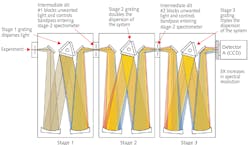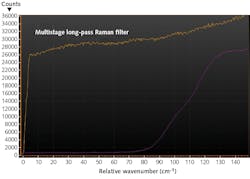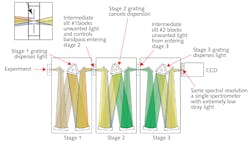Efficient Raman spectroscopy for materials science
The Raman spectrum of a material contains a wealth of information about the internal properties of materials, such as their elemental composition, which can be used for material identification, as well as the molecular, electronic, band, and energy structures. It can also demonstrate important interactions between charge carriers, atoms, and their environments.
Raman is sensitive to external parameters by detecting the response of the Raman spectrum—wavelength and intensity shift, as well as broadening of spectral lines in response to changes in temperature, pressure, and the chemical and molecular environment.
Raman spectroscopy has become a crucial tool in materials science research for characterization and development of new applications. Information obtained from the Raman signal is essential for progress in fields ranging from solar cell research, optoelectronic devices, quantum materials, biochemistry, synthetic catalysts, and more.
Demands on a spectroscopy system
As the applications of Raman spectroscopy cover such a broad range, it is not surprising that there are a wide range of requirements for a Raman spectroscopic system for different uses. However, advanced materials science research often requires one or several properties:
High resolution. Resolution describes the ability of a spectroscopic system to separate and detect spectral lines at different wavelengths. Systems with high resolution will show more information and fine structure in spectra and be better in measuring small shifts of spectral line positions.
Adapting the system to different materials. Research labs will often experiment with different materials and experimental setups operating at different excitation and detection wavelengths, in addition to different detectors optimized for specific experiments, such as time-resolved vs. steady-state measurements.
High stray light rejection. Stray light rejection describes the capability of a system to suppress background and environment light that are not part of the Raman signal. Practically high stray light rejection is equivalent to the ability of a system to measure spectral features in very close vicinity to the laser line.
Most Raman spectroscopy systems use powerful optical filters to suppress elastic Rayleigh scattering of the excitation laser, which is typically a factor of 106 or more stronger than the weak Raman signal. Multistage spectrographs suppress the laser light without optical filters and can give higher resolution and stray light suppression compared to most filter-based systems.
Multistage systems
Figure 1 shows a schematic view of a triple-spectrograph system. Light coupled into the entrance slit will be dispersed by a diffraction grating into its different wavelength components and focused onto the exit plane of the spectrograph.
In multistage systems, this process is repeated multiple times, with the exit slit of one spectrograph acting as the entrance slit for the next stage. Signal is detected by a camera at the exit of the last stage. This way of operating the three-stage system, demonstrated in Figure 1, is additive mode, as the dispersion of each stage adds up to increase the resolution (up to 3X more than equivalent spectrographs and gratings in each stage). Rayleigh scatter is removed by tuning the gratings so light at the laser wavelength can’t pass the intermediate slits.
High performance, wavelength-tunable
How does the filter capability of multistage spectrographs compare to optical filters? Figure 2 shows the transmission of a state-of-the-art Raman long-pass filter compared to a multistage spectrograph; both have cutoffs around 100 cm-1 from the laser position. However, transition width of the multistage system is significantly lower, enabling measurement of signals much closer to 100 cm-1.In addition, Raman filters are designed for operation at their design laser wavelength. The transmission edge of the multistage system can be tuned continuously to any wavelength and can also give high performance from UV (where optical filter performance and availability is low) to near-infrared (near-IR) by rotating the gratings inside each stage. Modern multistage systems are extremely stable and contain precise grating drive systems, allowing specific wavelength positions to be programmed and reproduced repeatedly.
Adapting to different excitation wavelengths makes multistage systems ideal for use with tunable lasers and other broadband light sources, including at synchrotron facilities.
Resonant Raman spectroscopy of 2D materials
Wavelength-tunable multistage systems work well for resonant Raman spectroscopy experiments. Tuning the excitation wavelength in resonance with an electronic transition in the sample material can lead to a significant enhancement of the Raman scattering intensity.
One benefit of resonant Raman spectroscopy is the measurement of samples at much lower concentrations, which would not produce a detectable signal in ordinary Raman scattering. However, resonant Raman gives insights into the internal structure of materials and molecules. For example, electronic transitions can be confined to specific regions of large molecules (chromophores) affecting only Raman bands associated with vibrations of molecular bonds in that region. Recently, resonant Raman measurements have turned out to be a valuable tool in the characterization of 2D materials, transition metal dichalcogenides (TMDs), and van der Waals heterostructures.
Resonant Raman spectroscopy of 2D materials and TMD 2D materials refers to ultrathin atomic layers down to single-atomic-layer thickness. Although graphene was the first 2D material to be widely investigated, a wide range of 2D materials are now being explored. Similar graphene TMDs built layered structures that are bound by van der Waals interactions. While graphene is a semimetal, TMDs are semiconductors that enable more ways of device design based on 2D materials.
Aside from investigating intrinsic properties, 2D materials can be combined to van der Waals heterostructures, which are now widely investigated for their potential in new electronic and opto-electronic device applications.
Raman spectroscopy has always played an important role in 2D materials research, as it allows for nondestructive and quick measurement of the number of layers of a material, characterization of defects, charge doping, and stress and strain states. Raman spectroscopy also gives insight into the interactions between layers in van der Waals heterostructures. The twisting angle, the relative rotation of lattice orientation in each layer, can sensitively influence physical and optical properties.
Raman spectra of 2D materials turn out to be very sensitive to changes in the laser wavelength, and resonant Raman spectroscopy is now an important measurement technique for their characterization. As TMDs are semiconductor materials, resonant Raman enhancement is observed when the excitation laser is resonant with exciton transitions. However, through multi-phonon scattering, lattice vibrations can connect exciton states at different positions of the band structure of TMDs—even so-called dark exciton states of TMDs that would not be measurable in standard photoluminescence experiments. Resonant Raman spectroscopy of TMDs therefore gives useful insights into their band structure.
In heterostructures, exciton states can also be differentiated between intralayer and interlayer excitons depending on the confinement of the electron and hole states. Resonant Raman spectroscopy has been successfully used to measure these interactions as well as hybridized superpositions between these states.
Measurement of resonant Raman spectra requires systems that can be quickly tuned to different excitation wavelengths while maintaining high performance for filtering out laser light. This makes multistage spectrograph systems ideally suited for this measurement technique. As these systems can also operate at UV, visible, and near-IR wavelengths, there are no restrictions for measuring different combinations of van der Waals heterostructures that will have different exciton energies.
Stray light suppression and subtractive mode
The energy range below 200 cm-1, called the low-frequency or terahertz Raman range, contains Raman lines from low-energy vibrational modes that can illuminate characteristic properties of materials. For example, low frequency Raman shows shear vibrations and interactions between layers of 2D materials.
Standard filters cut off around 100 cm-1, making them unsuitable for low-frequency Raman operation. Volume holographic Bragg (VHB) filters allow measurements within a few wavenumbers of the laser excitation line. Still, VHBs are designed for a specific laser wavelength, which must be carefully selected due to the cutoff close to the laser line and require multiple filters for sufficient laser line rejection.Spin-flip Raman scattering of semiconductor quantum spins
Quantum materials are semiconductors, 2D materials, and low dimensional nanostructures being developed for applications in quantum information processing and quantum sensing. One implementation of quantum computing is based on optical manipulation spin-based quantum bits, as well as coherent superpositions of spin-up and spin-down states that can be initialized, controlled, and read out by short laser pulses. Semiconductor quantum dots are one class of materials that is being researched to enable this application in better ways.
Research examines the fine structure of spin states in magnetic fields, where they are split in energy by the Zeeman effect due to their long coherence lifetimes, which is important for realistic applications. Optical spectroscopy provides important insights into the energy fine structure as well as perturbing interactions that limit the coherence times. Spin-flip Raman scattering is an interesting technique to investigate these properties of semiconductor quantum dot spin states. This technique is akin to Raman scattering, although initial and final material states have different spin states instead of vibrational states.
Spin-flip Raman scattering requires a high-resolution spectroscopic system that can observe the small, fine structure splitting of spins with signals as close as 2 cm-1 (or 0.25 meV) from the laser line. As individual quantum dots will have different energy levels at different energies, the system must be able to operate with tunable excitation laser systems while also maintaining high stray light suppression.
Multi-stage spectrographs are high performance spectral instruments. High-resolution detection of spectral lines close to the laser excitation, as well as operation at any wavelength from the UV to the near-IR without use of optical filters, makes these systems a valuable tool for applications in quantum materials, 2D, and other materials research.
About the Author
Sebastian Remi
Applications Scientist, Teledyne Princeton Instruments
Sebastian Remi is Applications Scientist at Teledyne Princeton Instruments, Acton, MA.



